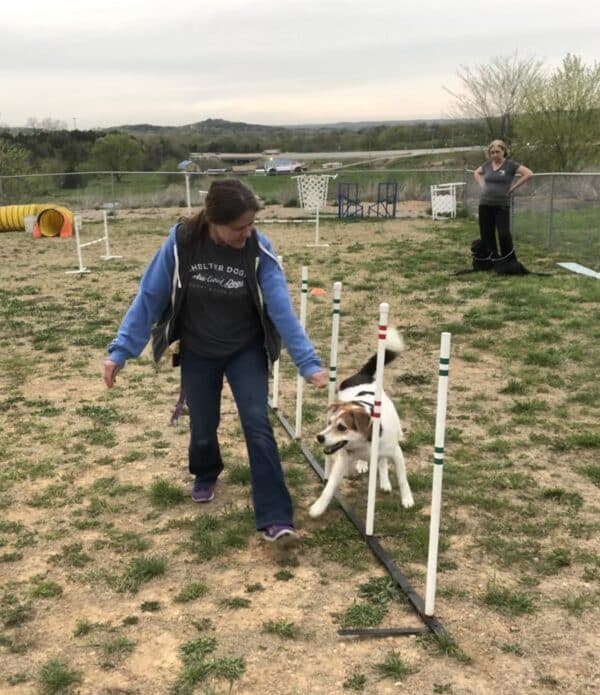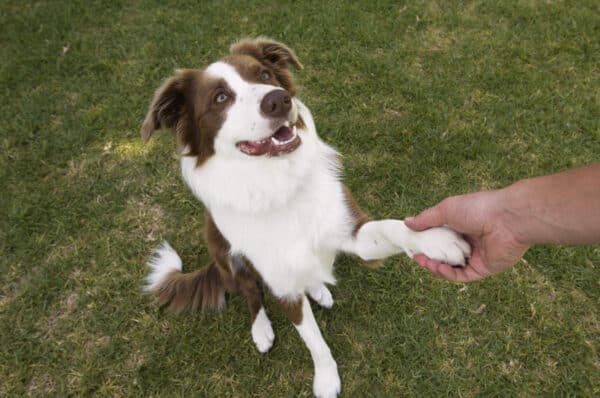Dog clicker training employs a toy noisemaker (clicker) to mark wanted behaviors. The clicker becomes a “conditioned reinforcer” by being paired repeatedly with things the dog wants to work for (often, but not always food) which we then use to communicate to our dogs, “I like that, do it more often!”
A Brief History Of Dog Clicker Training
While many view dog clicker training as a fad, marker training originated in B.F. Skinner’s work and was further developed by Marion Breland Bailey, Keller Breland, and later, Bob Bailey decades ago. Clicker training has been used to train hundreds of species, including fish, hermit crabs, horses, cats, chickens, tigers, elephants, rabbits, rats, marine mammals, even people!
It wasn’t until dog trainers read Karen Pryor’s seminal work Don’t Shoot the Dog that clicker training became widely embraced in the dog training community.
What Do I Need To Start Dog Clicker Training?
- Clicker
- Pouch for treats
- Tasty treats
- An animal
Dog Clicker Training Tips
The first step is developing your mechanical skills – before you even start training your dog! To build your mechanical skills, check out Tia Guest’s article, which includes a helpful clicker training video.
Once you’ve built your mechanical skills, “charge the clicker.” Grab some small, tasty treats. Press the clicker button (avoid clicking near your dog’s ears), then give your dog a treat. Start with 15 treats, and do three separate sessions of 15 treats your first day. Then, when your dog is relaxing across the room from you, click. Does your dog look at you, ears perked, coming to receive his treat? If so, the clicker is charged and you can begin using it for training. If not, charge the clicker for a few more short sessions.
If your dog is afraid of the sound, try a softer clicker or try using a retractable ball point pen or a Snapple lid. Every time you click, deliver a reinforcer, ideally within 1-2 seconds of the click, especially for beginner dogs. Think of the clicker like your dog’s paycheck – clicking without treating is like having your paycheck bounce at work…would you go back to work on Monday?
Food is generally the easiest reinforcer to start with. Later on, you can incorporate toys and games your dog likes.
Think of the clicker like a camera with which you “take a picture” of behaviors you like, as your dog offers them. If you are clicking sits, click as your dog’s butt hits the floor, then deliver a treat. If your click is late, you missed the picture – click as your dog sits or lies down, not after.
When clicker training, avoid adding a cue until the dog is performing the behavior reliably. You want a nice steady rhythm of behavior, click, treat; behavior, click, treat. As soon as your dog eats the treat, he offers another sit.
At this point, you may begin adding the cue. Say the word “sit” as your dog’s butt lowers toward the ground, then click when he sits. Toss the treat away so he has to get up to eat it, this sets him up for another sit. If he offers a hesitant lowering of his butt, click anyway – he is trying to make the association between the word and the behavior.
Once he is responding to the cue reliably, start proofing for fluency so that your dog will respond to the cue reliably in a number of different environments, even at a distance.
Clicker Myths
Clicker trainers always carry a clicker and food. The clicker is a teaching tool for new behaviors. Once the behavior is on cue and fluent to your standards, the clicker is no longer needed. You can then phase out treats, phase in play and life rewards, and only reinforce with treats occasionally.
Clicker trainers ignore unwanted behavior. While extinction can actually be a very effective tool for modifying behavior, but will not work for self-reinforcing behaviors. Clicker trainers use a combination of management (preventing opportunity to rehearse unwanted behavior), negative punishment (the doggy equivalent of a “time out?) and training incompatible behaviors (a dog can’t jump if he’s sitting) to address self-reinforcing behaviors. Clicker trainers focus on what they want the dog to do instead of the unwanted behavior in question.
All clicker training is created equal. Not all trainers who use clickers are “clicker trainers,” as many trainers use a clicker combined with leash corrections. Clicker training doesn’t work for certain dogs/breeds. All dogs can learn through clicker training, regardless of breed or age!
Think your voice is just as effective as a clicker for marking behaviors? Not so! Research by Lindsay Wood indicates a clicker is a faster, more efficient marker for behaviors than a verbal marker.
Learn More
This is only a brief introduction to clicker training. Want to learn more? Check out:




